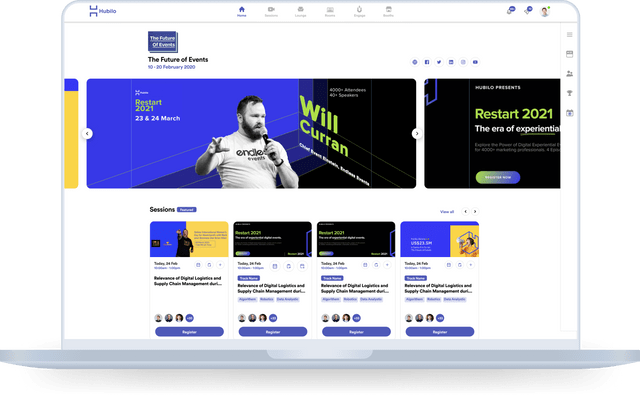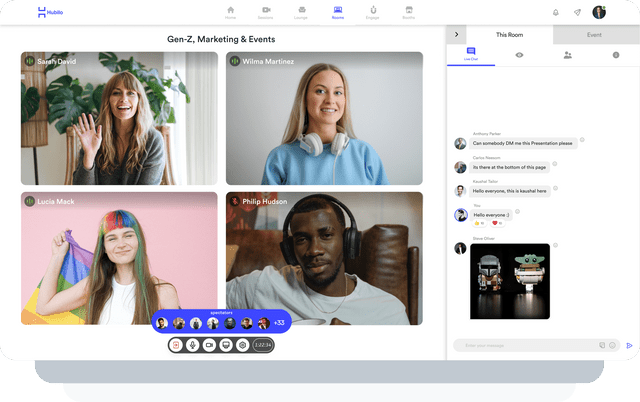Partner content in association with Hubilo
‘We are building a strong foundation for the future of virtual events’, says Hubilo founder Vaibhav Jain
Vaibhav Jain, Founder and CEO at Hubilo
In an exclusive article, Vaibhav Jain, CEO and founder, of Hubilo, makes a case for virtual events, the unique opportunities they offer that help maximise return on investment, and what is next for global events
Companies across the globe spend around a trillion dollars every year on events of all kinds, including marketing summits, annual sales kick-offs, career fairs, town halls, and trade shows that bring people together every day—in person or virtually. All of these rely on the expertise of event technology platforms enabled with a series of integrations, for reference, sales and marketing applications like Salesforce, Mailchimp, Hubspot, and Marketo to run targeted campaigns and measure the ROI; similarly, one can sync all your favourite apps (social media apps, gamification apps, and custom or third-party apps) with the event, getting attendees to engage more helping you to keep the connection live.
Moving forward, there is unlikely to be an event that doesn’t have a virtual component. From the most exclusive conferences and mega-trade shows to concerts and sporting events, marketing and events teams gain a wealth of insights (data analytics) about their audiences when these integrations are used.
Using the data collected through virtual interaction with events, marketers can determine what attendees are doing, what they want more of, and how best to provide it – even optimised in real-time. Rather than simply use the current event to plan the next one, digital-first teams can offer audiences personalised experiences curated from engagement behaviours that keep attendees deeply immersed and more engaged.
Keeping up with the pace of change
One of the biggest challenges for event planners in the early transformation to digital was knowing which platform to use and how to use it in a way that suited their needs. With specific tools and technology, event professionals began to provide valuable feedback on functionality and significant insights into how technology could be more useful to their needs and more engaging for their audiences.
At Hubilo, one of the world’s leading virtual and hybrid event platforms, we involve our customers as well as the broader market to inform our product development, and we have built-in a strong feedback framework that enables us to collaborate in innovation with some of the most creative minds in the industry.

Virtual events are no longer the stopgap measure between our in-person past and returning to “normal.” If marketing and sales teams are still utilising old-school tools used prior to the pandemic, they are missing out on an opportunity to shape the future of events.
The major innovations in this transition will only come from agile teams who can apply the latest technology to the newest trends to create the new world of virtual and hybrid connections by utilising the most robust solutions on the market.
Now that virtual and hybrid events have connected customer needs to the digital sphere, we’re beginning to anticipate and predict what features will be required to efficiently engage attendees in ways they haven’t realised possible. For example, speakers, panelists, and hosts devote a great deal of time to creating event content. Hubilo is developing tools that will allow customers to take their event content and more quickly and seamlessly turn them into blogs, eBooks, and social media content automatically.
More flexibility, more opportunities
Marketing leaders have seen the benefits of engaging many-to-many virtual events over standard livestream or one-to-many communications. From data capture to larger real-time global audiences, hybrid and virtual events offer multiple times greater return on investment (ROI).
As excited as we are to end in-person restrictions and risks, even in-person majority conferences will have virtual components that make the entire planning process seamless, simple, and easy to operate.
We will see new modes of engagement as virtual events emerge without a physical predecessor to model on. However, visionaries won’t be using bare-bones platforms to attempt this since they will need a solid foundation of technology, customer support, and greater ease of use.
When evaluating options, teams should look for technology that lets them easily scale from 50 users to over 500,000. Beyond broadcasting a single presentation to the audience and speakers receiving clunky interactions, events should have the functionality to let online users interact just like they would if they were physically present.
Building ‘Next’
Even if a platform offers the technology capabilities an event team is looking for, they are seeking technical expertise they, themselves, haven’t had to employ before. At Hubilo, we believe they deserve x, y, and z. And Hubilo is delivering it!

That is why we let marketing and sales teams dream and imagine while our client experience teams work with them to apply it to the technology available, from the main session video production to the day-of troubleshooting.
The potential of hybrid events and virtual experiences is exponential. As we develop the future at Hubilo, we strive to make the strongest foundation for global events. By pushing the envelope when it comes to innovating new features, upgrading existing tools, and integrating existing stack applications, we’re reimagining events as we know them.
This article was created in partnership with Hubilo. Click here to know more about the potential of immersive events



